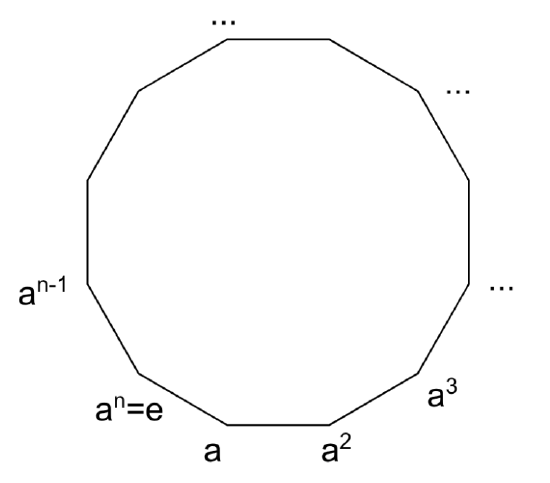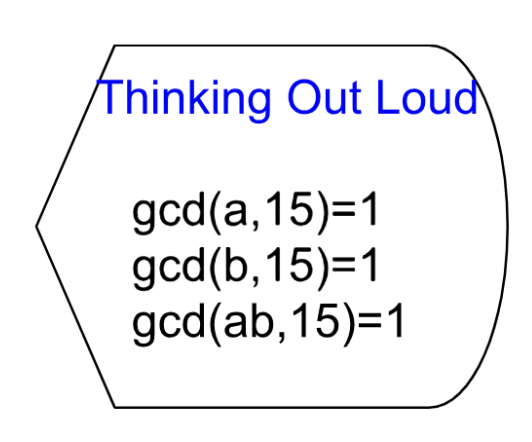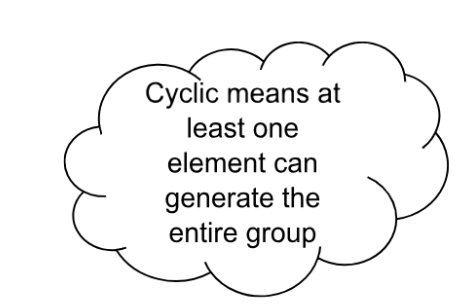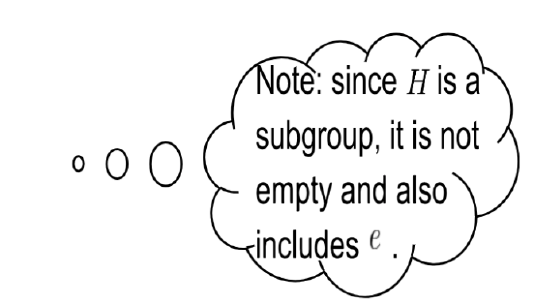2.4: Cyclic groups
( \newcommand{\kernel}{\mathrm{null}\,}\)
Order of group element
Let (G,⋆) be a group.
Let a∈G, then the order of an element a∈G, denoted by |a|, be the smallest positive integer n s.t. an=e. If no such n exists, we say that the order is infinite.
Consider the group Z10 with addition modulo 10. What is the order of its elements?
Consider Z10={0,1,2,3,4,5,6,7,8,9}. Note that {0} is the identity and its order is 1.
|
element |
Order |
Calculations |
|
0 |
|⟨0⟩|=1 |
|
|
1 |
|⟨1⟩|=10 |
110≡0(mod10) |
|
2 |
|⟨2⟩|=5 |
21≡2(mod10), 22≡4(mod10), 23≡6(mod10), 24≡8(mod10), and 25≡0(mod10). |
|
3 |
|⟨3⟩|=10 |
31≡3(mod10), 32≡6(mod10) , 33≡9(mod10), 34≡2(mod10), 35≡5(mod10), 36≡8(mod10), 37≡1(mod10), 38≡4(mod10), 39≡7(mod10), and 310≡0(mod10). |
|
4 |
|⟨4⟩|=5 |
41≡4(mod10), 42≡8(mod10), 43≡2(mod10), 44≡6(mod10), and 45≡0(mod10). |
|
5 |
|⟨5⟩|=2 |
51≡5(mod10), and 52≡0(mod10). |
|
6 |
|⟨6⟩|=5 |
61≡6(mod10), 62≡2(mod10), 63≡8(mod10), 64≡4(mod10) and 65≡0(mod10). |
|
7 |
|⟨7⟩|=10 |
71≡7(mod10), 72≡4(mod10), 73≡1(mod10), 74≡8(mod10), 75≡5(mod10), 76≡2(mod10), 77≡9(mod10), 78≡6(mod10), 79≡3(mod10), and 710≡0(mod10). |
|
8 |
|⟨8⟩|=5 |
81≡8(mod10), 82≡6(mod10), 83≡4(mod10), 84≡2(mod10), and 85≡0(mod10). |
|
9 |
|⟨9⟩|=10 |
91≡9(mod10), 92≡8(mod10), 93≡7(mod10), 94≡6(mod10), 95≡5(mod10), 96≡4(mod10), 97≡3(mod10), 98≡2(mod10), 99≡1(mod10), and 910≡0(mod10). |
The order of a group is the number of elements in the group.
The order of an element a∈G, denoted by |a|, be the smallest positive integer n s.t. an=e.
Let (G,⋆) be a group.
Let X={x1,x2…,xn} where x1,x2…,xn∈G, then the subset of G generated by X denoted by ⟨X⟩ is
{xm11xm22⋯xmnn∣m1,m2⋯,mn∈Z}.
Let (G,⋆) be a group.
Let a∈G, then define the set generated by a denoted by ⟨a⟩ is {am|m∈Z}={⋯,a−2,a−1,e,a,a2,⋯}.
Note: a0=e.
Let (G,⋆) be a group.
Let a∈G, then ⟨a⟩ is the smallest subgroup of G that contains a.
- Proof
-
Let (G,⋆) be a group. Let a∈G. If a=e then ⟨a⟩={e} is the smallest subgroup of G that contains e.
Suppose a≠e. Clearly e∈⟨a⟩. Let g,h∈⟨a⟩. Then g=am for some m∈Z and h=an for some n∈Z.
Consider gh−1=am(an)−1=ama−n=am−n. Since m−n∈Z, gh−1∈⟨a⟩.
Thus, ⟨a⟩≤G. Suppose H is a subgroup of G that contains a. Clearly, ⟨a⟩≤H. ◻
Let (G,⋆) be a group.
Let a∈G, then ⟨a⟩ is called cyclic subgroup of G.
If G=⟨a⟩ for some a∈G, then G is called a cyclic group.
Remember the definition of a unitary group:
Let n be a positive integer. Then define U(n)={a∈Z+|gcd(a,n)=1}. Then (U(n),⋅(modn)) is an abelian group. U(n) is a unitary group of order |ϕ(n)| .
U(15)={1,2,4,7,8,11,13,14} and ⋆=⋅(mod15).
Let a∈U(15) and b∈U(15).
Then a(x)+15(y)=1 and ab(x)+15by=b therefore U(15) is closed.
Since U(15) is a finite group, the order of the group is |U(15)|=8.
However, U(15) is not a cyclic group.
Proof: (by exhaustion)
Let a∈U(15).
We will show that ∄a∈U(15), s.t. |⟨a⟩|=8.
|⟨1⟩|=1 since 11≡1(mod15)
|⟨2⟩|=4 since 24≡1(mod15)
|⟨4⟩|=2 since 42≡1(mod15)
|⟨7⟩|=4 since 74≡1(mod15).
|⟨8⟩|=4 since 84≡1(mod15).
|⟨11⟩|=2 since 112≡1(mod15).
|⟨13⟩|=4 since 134≡1(mod15).
|⟨14⟩|=2 since 142≡1(mod15).
Since ∄a∈U(15), s.t. |⟨a⟩|=8, U(15) is not a cyclic group.◻
Prove that (U(14),(⋅(mod14))) is cyclic. 
Proof:
We will show that ∃a∈U(14) s.t. |⟨a⟩|=|U(14)|.
Consider U(14)={1,3,5,9,11,13} where |U(14)|=6.
Consider 31≡3(mod14), 32≡9(mod14), 33≡13(mod14), 34≡11(mod14), 35≡5(mod14) and 36≡1(mod14).
|⟨3⟩|=6 since 36≡1(mod14).
Thus |⟨3⟩|=6.
Therefore, U(14) is cyclic and 3 is a generator.◻
The following is an infinite cyclic group. Any infinite cyclic group is isomorphic to this group.
Is (Z,+) cyclic group? If so, what are the possible generators?
Yes, (Z,+) is a cyclic group that is generated by ±1.
Proof of being a cyclic group:
Since the group generated by 1 contains 1, the identity 0, and the inverse of 1,(−1), as well as all multiples of 1 and (−1), (Z,+) is cyclic.
Possible Generators:
Note 1n is 1+1+⋯+1 with n terms when n⟩0 and (−1)+(−1)+⋯+(−1) with n terms when n is ⟨0.
We shall show Z=⟨1⟩=⟨−1⟩.
Consider that 1n means 1+1+⋯+1 with n terms and that 1−n means +(−1)+(−1)+⋯+(−1) with n terms.
It should be clear that 1n will generate Z+ and that 1−n will generate Z−. Note that 10 is interpreted as 0⋅1=0.
⟨1⟩={…,−3,−2,−1,0,1,2,3,…}.
Thus ⟨1⟩ is a generator of (Z,+).
Similarly, we will show that ⟨−1⟩ is a generator of (Z,+).
Consider that (−1)n means +(−1)+(−1)+⋯+(−1) with n terms and that 1−n means 1+1+⋯+1 with n terms.
It should be clear that 1n will generate Z− and that 1−n will generate Z+. ⟨−1⟩={…,−3,−2,−1,0,1,2,3,…}.
Thus the generators of (Z,+) are ⟨1⟩ and ⟨−1⟩.
Properties:
Cyclic groups are abelian.
- Proof:
-
Let (G,⋆) be a group.
If G is cyclic, then G is abelian.
Assume that G is cyclic.
Then G=⟨g⟩ for some g∈G.
Let a,b∈G.
We will show ab=ba.
Then a=gm and b=gn, m,n∈Z.
Consider ab=gmgn=gm+n=gn+m=gngm=ba.
Hence, G is abelian.◻
The converse is not true. Specifically, if a group is abelian, it is not necessarily cyclic. A counterexample is (U(15),∙) since it is abelian but not cyclic.
Every subgroup of a cyclic group will be cyclic.
Let (G,⋆) be a cyclic group. If H≤G, then H is a cyclic group.
- Proof
-
Let G=⟨g⟩,g∈G.
We will show H=⟨gk⟩ for some k∈Z.
There are two cases to consider.

Case 1: H={e}
Let H={e}, then we are done since e⋆e=e thus |H|=|⟨e⟩|=1.
Case 2: H≠{e}
Let H≠{e}.
Thus ∃h∈H s.t. h≠e.
Since h∈H, h∈G.
Hence h=gm for some m∈Z.
Without loss of generality, we may assume m∈N.

Define S={n∈N|gn∈H}⊆N.
Since S(≠{}) by the well ordering principle S has a smallest element k.
We shall show that H=⟨gk⟩.
Since gk∈H, ⟨gk⟩≤H.

Let h∈H.
We shall show that h∈⟨gk⟩.
Since h∈H, h=gm,m∈Z.
Since k,m∈Z, by the division algorithm, there exists q,r s.t. m=qk+r,0≤r<k.
Then gm=gqkgr and gm−qk=gr.
Since gm,gqk∈H, then gr∈H.
Since k is the smallest, r=0. (I think this is because g0=e)
Therefore gm=(gk)q∈⟨gk⟩.
Thus H≤⟨gk⟩.◻

The Converse is not true. Every sub-group of the Klein 4-group is cyclic, but not the group.
Subgroups of (Z,+) are of the form (nZ,+), n∈N.
Let G be a cyclic group s.t. G=⟨a⟩ and |G|=n.
Then ak=e iff n|k.
- Proof
-
Let G=⟨a⟩ with an=e.

⟨a⟩={e,a,a2…,an−1}.
Let ak=e,k∈Z.
Since by the division algorithm, unique integers q and r exist such that k=nq+r,0≤r<n,q,r∈Z.
Consider ar=ak−nq
=ak(an)−q Note: ak=e is our assumption & n is the order of group.
=ee−q
=e.
 Hence r=0.
Hence r=0.Thus k=nq.
Therefore n|k.
Conversely, assume that n|k.
Then k=nm,m∈Z.
ak=anm.
=(an)m
=em
=e.
Hence the result.◻
Consider the group Z12 with addition modulo 12.
1. Is (Z12,+mod(12)) cyclic group? If so, what are the possible generators? How many distinct generators are there? What can you say about the number of generators (hint: Euler totient number) and the possible generators (Hint: Divisors)?
3. Find all subgroups of Z12 generated by each element. What are the orders of them? What can you say about these orders?
- Answer
-
1. Consider Z12={0,1,2,3,4,5,6,7,8,9,10,11} with addition modulo 12. Note that {0} is the identity and its order is 1.
Element
Order
Calculations
0
|⟨0⟩|=1
1
|⟨1⟩|=12
112≡0(mod12)
2
|⟨2⟩|=6
21≡2(mod12), 22≡4(mod12), 23≡6(mod12), 24≡8(mod12), 25≡10(mod12) and 26≡0(mod12).
3
|⟨3⟩|=4
31≡3(mod12), 32≡6(mod12) , 33≡9(mod12), and 34≡0(mod12).
4
|⟨4⟩|=3
41≡4(mod12), 42≡8(mod12), and 43≡0(mod12).
5
|⟨5⟩|=12
51≡5(mod12), 52≡10(mod12), 53≡3(mod12), 54≡8(mod12), 55≡1(mod12), 56≡6(mod12), 57≡11(mod12), 58≡4(mod12),59≡9(mod12), 510≡2(mod12), 511≡7(mod12), and 512≡0(mod12).
6
|⟨6⟩|=2 61≡6(mod12), and 62≡2(mod12).
7
|⟨7⟩|=12
71≡7(mod12), 72≡2(mod12), 73≡9(mod12), 74≡4(mod12), 75≡11(mod12), 76≡6(mod12), 77≡1(mod12), 78≡8(mod12), 79≡3(mod12), 710≡10(mod12), 711≡5(mod12), and 712≡0(mod12).
8
|⟨8⟩|=3
81≡8(mod12), 82≡4(mod12) and 83≡0(mod12).
9
|⟨9⟩|=4
91≡9(mod12), 92≡6(mod12), 93≡3(mod12) and 94≡0(mod12).
95≡5(mod10), 96≡4(mod10), 97≡3(mod10), 98≡2(mod10), 99≡1(mod10), and 910≡0(mod10).
10 |⟨10⟩|=6 101≡10(mod12), 102≡8(mod12), 103≡6(mod12), 104≡4(mod12), 105≡2(mod12) and 106≡0(mod12).
11 |⟨11⟩|=12 111≡11(mod12), 112≡10(mod12), 113≡9(mod12), 114≡8(mod12), 115≡7(mod12), 116≡6(mod12), 117≡5(mod12), 118≡4(mod12), 119≡3(mod12), 1110≡2(mod12), 1111≡1(mod12), and 1112≡0(mod12). From the table, (Z12,+mod(12)) is a cyclic group, the set of all possible generators are {1,5,7,11}={a∈Z|gcd(a,12)=1,1≤a<12}. Hence, the number of generators is the same as the number of integers relatively prime to 12=223. That is, the number of generators is the Euler totient number ϕ(12)=(22−2)(31−1)=4.
2. From the above table, we see that the orders of the subgroups are 1,2,3,4,6 and 12, which are all divisors of the order of Z12. Specifically, the order of the subgroup generated by g∈Z12 is ngcd(g,n).
Note that 12=223. Then the cyclic subgroups are ⟨1⟩,⟨6⟩,⟨4⟩,⟨3⟩,⟨2⟩,⟨0⟩ with orders 12,2,3,4,6 and 1.

⟨ak⟩=⟨agcd(n,k)⟩
Let G=⟨a⟩ be a cyclic group with |G|=n.
Let b∈G.
If b=ak then |b|=nd,d=gcd(k,n).
- Answer
-
Let G=⟨a⟩ with |G|=n and a∈G.
Let an=e.
We will show that ⟨ak⟩=⟨agcd(n,k)⟩.

Let x∈⟨ak⟩.
Since gcd(n,k)=d for some d∈Z+, d|n and d|k.
Thus, k=md,m∈Z.
Consider an arbitrary power of ak, (ak)j∈⟨ak⟩.
(ak)j=(amd)j=(ad)jm∈⟨ad⟩∈⟨agcd(n,k)⟩.
Let d=xn+yk,n,k∈Z.
Using the division algorithm, (axn+yk)h=(an)xh(ak)yh,n,k,h∈Z
=(ak)yh∈⟨ak⟩.
Thus ak=ad.
Now we want to show |ak|=nd.
Consider (ak)nd=(an)kd=ekd=e.
Thus |ak|≤nd.
Now consider (ad)nd=(an)=e⇒|ad|≤nd.
Now consider 0≤i<nd.
Thus di<n, where d is positive since it is the greatest common denominator.
Thus (ad)i=adi≠e for di<n.
Then we can show |ad|=nd.
Consider |ak|=|⟨ak⟩|=|⟨ad⟩|=|ad|=nd.
Hence |ak|=nd.
Let G=⟨g⟩ be a cyclic group with |g|=n. Then G=⟨gk⟩ if and only if gcd(k,n)=1.
- Proof
-
Let G=⟨g⟩ be a cyclic group with |g|=n. Then
g∈G and gn=e.Assume that G=⟨gk⟩. Then g=(gk)x for some x∈Z.
Thus,
g1−kx=e.
By Theorem 2.4.5, n∣(1−kx). Therefore,
1−kx=ny, for some y∈Z.
Which implies,
1=kx+ny,
hence,
gcd(k,n)=1.Conversly, we shall show that if gcd(k,n)=1, then G=⟨gk⟩.
Suppose that gcd(k,n)=1. Then
kx+ny=1, for some x,y∈Z.
By using the properties of powers in a group and gn=e, we get,
g1=gkx+ny=(gk)x(gn)y=(gk)x.Hence g∈⟨gk⟩.
Therefore, we have G⊆⟨gk⟩. Since ⟨gk⟩ ⊆G,
G=⟨gk⟩.
Let G=⟨a⟩ be a cyclic group with |G|=n. Prove the following statements:
a) If H≤G then H=⟨ak⟩ for some integer k that divides n.
b) If k|n then ⟨ank⟩ is the unique subgroup of G of order k.
- Proof
-
a) Let G=⟨a⟩ with |G|=n. Assume that H≤G. By Theorem 2.4.3, H is cyclic. Hence H=⟨ak⟩ for some integer k∈Z. Let d=gcd(k,n). We shall show that H=⟨ad⟩. Since d=gcd(k,n), kx+ny=d, for some x,y∈Z. Consider, ad=akx+ny=(ak)x(an)y=(ak)x. Thus ad∈H. Therefore ⟨ad⟩⊆H.
Since d|k,k=md, for some m∈Z. Thus, ak=amd=(ad)m. Hence H⊆⟨ad⟩. Thus H=⟨ad⟩ and d|n.b) Let G=⟨a⟩ with |G|=n. Assume that k|n. Suppose K be subgroup of G of order k. We shall show that K=⟨ank⟩. Since K is a subgroup of G, K=⟨am⟩, for some, m∈Z. By part a, m|n. Then (am)n/m=e. We shall show that nm is the smallest positive integer with this property.
Now, |K|=nm=k. Thus, m=nk. Thus K=⟨ank⟩ which is unique.
A group of prime order is cyclic.
- Proof
-
Let G be a group s.t. |G|=p, where p is a prime number.
Let g∈G s.t. H=⟨g⟩ is a subgroup of G.Since p>1, g≠{e}.
Since H is cyclic, ∃gk=e, for some k∈Z.
By the division algorithm, k=nq+r where 0≤r<n.
Hence, e=gk=gnq+r=gnqgr=egr=gr.
Since the smallest positive integer k such that gk=e is n, r=0. Thus n|k.
Conversely, if n|k, then k=nm, m∈Z.
Consequently, gk=gnm=(gn)m=em=e.
Thus, |⟨g⟩| divides |G|.
Consider that the only two divisors of a prime number are the prime number itself and 1.
Since p<1, |G|=p.
Since |G|=p, G is cyclic.◻
List all the cyclic subgroups of U(30).
U(30)={1,7,11,13,17,19,23,29} and |U(30)|=8.
|
k |
Calculations |
|k| |
|
7 |
71≡7(mod30), 72≡19(mod30), 73≡13(mod30), 74≡1(mod30) |
4 |
|
11 |
111≡11(mod30), 112≡1(mod30) |
2 |
|
13 |
131≡13(mod30), 132≡19(mod30), 133≡7(mod30), 134≡1(mod30) |
4 |
|
17 |
171≡17(mod30), 172≡19(mod30), 173≡23(mod30), 174≡1(mod30) |
4 |
|
19 |
191≡19(mod30), 192≡1(mod30) |
2 |
|
23 |
231≡23(mod30), 232≡19(mod30), 233≡17(mod30), 234≡1(mod30) |
4 |
|
29 |
291≡29(mod30), 292≡1(mod30) |
2 |
Since ∄a∈U(30) s.t. |⟨a⟩|=|U(30)|=8, U(30) is not a cyclic group.
However the following subgroups of U(30) are cyclic: {1,7,13,19}, {1,17,19,23}, {1,11}, {1,19}, {1,29} and {1}.
Let n≥1. Then U(n) is cyclic iff n=1,2,4,pk or 2pk where p is an odd prime and k≥1.
U(n) is not cyclic if n is divisible by two distinct odd primes or by 4 and an odd prime.
U(1),U(2),U(3),U(4),U(5),U(6),U(7),U(9),U(10),U(11),U(18),U(27) are cyclic.
U(8),U(16),U(20),U(30) are not cyclic.


